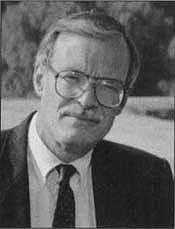All Issues
Charting DANR's future
Publication Information
California Agriculture 49(3):2-2.
Published May 01, 1995
PDF | Citation | Permissions
Full text
Last month, 45 researchers and educators from all three Division campuses — Berkeley, Davis and Riverside — and more than a dozen county offices gathered at the Vallombrosa Retreat Center in Menlo Park to consider future directions for Division of Agriculture and Natural Resources (DANR) research and extension programs. These Agricultural Experiment Station faculty and Cooperative Extension Specialists and Advisors met as members of the newly organized DANR Program Planning and Advisory Committees (PPACs). Chosen for their scientific expertise and insight into the technological and social changes that are shaping California's future, each of these individuals serves on a committee — Agricultural Resources, Human Resources, or Natural Resources — charged with recommending Division-wide program priorities within their respective subject areas. Five members of each of these committees also serve on the Program Integration committee, which will identify cross-subject matter issues and goals and recommend overall program priorities for the Division.
Although constituted as four individual committees PPAC members chose to meet jointly at Vallombrosa. They took this collaborative approach recognizing that if the Division is to successfully meet the challenges of the next century, program planning must be coordinated across all subject-matter areas. Further, they recognize that Division-wide planning cannot depend exclusively on the insights of 45 individuals. Rather, all members of the Division should participate in the formulation of program priorities adopted for the organization as a whole. The PPACs also seek guidance from people affected by our work — the many clientele groups who participate in our programs, our colleagues in other organizations, and the public at large. Thus, the PPACs regard their task as a process of inquiry — requiring exploration and synthesis of the values and perceptions held by all the Division's “stakeholders.”
The Vallombrosa meeting concluded with a commitment by the PPAC members to actively seek input reflecting a diversity of perspectives on the question, “What are the priority needs that the Division of Agriculture and Natural Resources should address in the areas of agricultural, human and natural resources?”
PPAC members are aware that planning is ongoing at all levels within the organization. For example, each of the Division colleges and regional offices are engaged in assessing needs and setting priorities for their respective units, as are campus departments, county offices, Division workgroups and individual staff members. The conclusions reached through these localized planning efforts will be assimilated by the PPACs as they derive overall priorities for the Division as a whole. The PPACs plan to develop their preliminary recommendations by June, and expect to finalize their first-year report of recommended Division-wide program priorities in September 1995.
The PPACs' efforts to identify Division-wide program issues and goals coincide with other new initiatives in our strategic planning process. In May, the first in a planned series of “focus group” meetings will be conducted. Bringing together Division members from all subject fields and organizational units, along with a diverse sample of individuals from our public constituencies, these meetings will elicit new ideas for doing business in response to the challenges of the 21st century. Such changes might entail new kinds of programs as well as new organizational structures. Over the next six months, 100 to 200 individuals will participate in one of these focus groups.
Thus, Division planning is simultaneously underway at two levels: While the PPACs are leading an assessment of current and imminent issues specific to particular subject matter areas, the focus groups will yield recommendations for long-range repositioning of the Division, both in terms of program content and the way in which its programs are administered and conducted. The outputs of these two planning processes, reflecting the collective wisdom of the Division's diverse membership and constituencies, will converge in an ongoing series of strategic recommendations upon which DANR leadership can rely in charting a course for the future.
Although often perceived as a responsibility of administrators, strategic planning in fact begins with the people most involved in and most affected by the Division's programs. Further, strategic planning is not a one-time exercise, but an ongoing process. Given the unprecedented pace of technological, social and political change in our society, public institutions such as DANR must constantly reassess the role they are best suited to serve and how best to adapt to changing needs. The PPACs are committed to leading the Division in a continuing cycle of annual review and updating of program priorities. The result will be a strategic plan that is always current — a “living document” that provides immediate direction for our research and educational programs, as well as a long-term vision for our organization.
I encourage anyone interested in the Division's research and extension priorities to share his or her ideas with PPAC members. The four PPAC Chairs are identified below:
Agricultural Resources PPAC Chair: Howard Ferris, Phone: (916) 752–8432; hferris@ucdavis.edu
Human Resources PPAC Chair: James Grieshop, Phone: (916) 752–3008; jigrieshop@ucdavis.edu
Natural Resources PPAC Chair: Valerie Mellano, Phone: (619) 571–4204; Vmellano@AOL.com
Program Integration PPAC Chair: Victor Gibeault, Phone: (909) 787–3575; gibeault@ucrac1.ucr.edu





